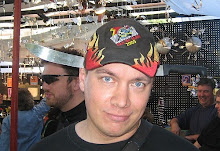
(kuva 25) Howard Johnson Inn:istä Las Vegasissa saimme melko tasokkaan huoneen ällistyttävän edullisesti. Kaupungin lukemattomat kasinot houkuttelevat turisteja niihin törsäämään rahojaan, joten majoitus on erittäin halpaa. Taustalla maailmankuulun pääkadun eli ´Stripin´ pohjoispäässä kohoava 350-metrinen Stratosphere-torni samannimisen kasinon kupeessa.
(picture 25) We got a nice room stunningly cheap from the Howard Johnson Inn in Las Vegas. The city is filled with casinos, that want to get as many tourists as possible to spend their money in them, so accommodation is dirt cheap. On the background you can see the Stratosphere-tower, which is 350 meters high, and lies at the northern end of the world famous main road, ´The Strip´ next to a casino with the same name.

(kuva 26) Kyltti, joka toivottaa tervetulleeksi Las Vegasin keskustaan. Keskusta kuitenkin sijaitsee tästä pohjoiseen, kun taas kaupungin tunnetuin nähtävyys, ´The Strip´, tästä etelään.
(picture 26) A sign welcomed us to downtown Las Vegas, which is north from the sign. The most famous part of the city, however, is ´The Strip´, and it is south from here.

(kuva 27) Stratosphere Casino iltakävelyllämme Las Vegasin ´Stripillä´, joka on USA:n ainoa maisemalliseksi määritelty päätie - pimeän aikaan! Lämpötila illalla oli 20-22 C, eikä aavikon ilma ole tavallisesti kovin kosteaa, joten t-paidassa oli juuri sopivan lämmin kävellä. Iltakävelymme pituudeksi tulikin varmasti ainakin 6-7 kilometriä!
(picture 27) Stratosphere Casino on our evening walk at the Las Vegas ´Strip´. It is the only scenic highway in the US - after dark! Temperature in the evening was about 20-22 C, and desert air is usually not very humid, so it was a perfect temperature to walk dressed on a t-shirt. We did walk, too - at least 6-7 kilometers during the evening!

(kuva 28) Las Vegas on paitsi ´maailman viihdepääkaupunki´, myös ´naimisiinmenopääkaupunki´! Vihkiluvan saa järjestettyä ilman odotusaikaa toimistosta, joka on auki joka päivä aamuyhdeksästä puoleenyöhön, ja kaupunki on täynnä pieniä vihkikappeleita (meidänkin motellissamme oli yksi). Myös itse seremonian toimittamiseen on lukemattomia vaihtoehtoja, ja jos niin haluat, sen voi toimittaa esimerkiksi vaikka Elviksen kaksoisolento!
(picture 28) Las Vegas is ´the entertainment capital of the world´, but also ´the wedding capital´. You can get the required permits without waiting period from an office that´s open every day from 9 am to midnight. The city is filled with small wedding chapels (our motel also had one). Also the way the ceremony is held, is fully up to you, if you want, you can have an Elvis impersonator handle it, for example!

(kuva 29) Maailmankuulua ´Stripiä´ reunustavat kilometrien matkalla valtavat hotelli-kasinokompleksit, joilla kullakin on oma teemansa, ja niiden edustalla järjestetään näihin istuvia esityksiä. ´Aarresaaren´ edessä oli valtava vesiallas, jossa kellui merirosvolaiva, ja sen kannella ja köysissä esiintyi miekkamiehiä ja vähäpukeisia tanssijoita humoristisessa merirosvo-show:ssa. Kasinon edusta oli tupaten täynnä ihmisiä esityksen aikaan. Amerikassa kun kaikki on suurta, veden alle mahtui tietysti piiloon toinen samanmoinen ´aavelaiva´, joka ilmestyi kesken esityksen mukaan kuvioihin.
(picture 29) The famous ´Strip´ is for many miles littered with enormous hotel-casino complexes, each built into its own theme, and there are shows according to the theme shown in front of them. ´Treasure Island´ was fronted by a large pool of water, with this ship floating on it, and we saw sword-armed pirates and scantily clad dancer-ladies perform a humoristic pirate-show on its deck and ropes. The front of the casino was filled with a huge crowd that had come to see it. And everything is big in America; the water pool was big enough to hide another ´ghost ship´ of same size under the surface, and it rose up during the show.

(kuva 30) Sisänäkymä eräästä kasinosta, joita kaupungissa on kymmeniä. Silmänkantamattomiin peliautomaatteja, ja ruletti-, blackjack- tai pokeripöytiä. Tämän kasinon aulassa oli esillä maukkaasti rakennettu show-harrikka (jolla ajaminen tosin ei taitaisi onnistua).
(picture 30) An inner view to one of the dozens of casinos in the city. There are seemingly endless rows of slot machines and roulette-, blackjack- or poker tables. In the entrance to this casino, there was a nicely built Harley on show. Did not look like it is meant to be ridden, though.

(kuva 31) Liiasta vaatimattomuudesta ei Las Vegasin hotelli-kasinoita ainakaan voi syyttää! Tässä ´Keisarin palatsin´ sisäänkäynti. Tämäkin kompleksi levittäytyi varmaan neliökilometrin alueelle!
(picture 31) You cannot blame the Las Vegas hotel-casinos for being too modest, that´s for sure! Here is the entrance to ´Caesar´s Palace´, and the whole complex spread out to roughly a half square-mile area!

(kuva 32) Näkymä vilkkaasti liikennöityä ´Stripiä´ etelään; olimme tässä vaiheessa kävelleet lämpimässä illassa jo kilometritolkulla, ja tie vain jatkui ja jatkui. Onneksi takaisin motellille pääsi myös kaksikerrosbusseilla. Alueella kulkee myös ilmakiskojuna.
(picture 32) A view to the south on the busy ´Strip´. We had walked for miles on the warm evening to get here, and the road just went on and on... luckily we were able to get back to the motel on a double-decker bus. There is also a monorail-train as public transport.

(kuva 33) ´Stripillä´ vastaan kävelivät tietysti myös ´Rockin kuningas´ sekä Marilyn iltakävelyllään...
(picture 33) Naturally ´The King of Rock n´Roll´ and Marilyn were also having an evening stroll along the ´Strip´...

(kuva 34) Kaikki, mikä on vanhaa ja eurooppalaista, tuntui noin yleisesti olevan USA:ssa kovassa huudossa. Ei ollutkaan yllätys, että Las Vegasista löytyi myös oma ´Venetsia´ kanavineen ja turisteja kuljettavine gondoleineen.
(picture 34) In general, everything that is old and European, seemed to be held in high value in the US. So it was not a big surprise, that from Las Vegas, you can even find its own ´Venice´, with the canals and gondols transporting tourists.


















































